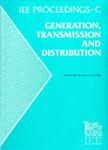版权所有:内蒙古大学图书馆 技术提供:维普资讯• 智图
内蒙古自治区呼和浩特市赛罕区大学西街235号 邮编: 010021

作者机构:Department of Electrical & Electronic Engineering University of Western Australia Crawley Australia
出 版 物:《IEE PROCEEDINGS-C GENERATION TRANSMISSION AND DISTRIBUTION》 (IEE Proc Part C)
年 卷 期:1981年第128卷第2期
页 面:55-62页
核心收录:
主 题:Network and transmission line calculations Integral transforms underground cable systems surge arresters nonlinear equations transients power networks electromagnetic transient analysis transient propagation Fourier transform Newton Raphson algorithm underground cables transmission networks Z transforms crossbonded cable transmission systems
摘 要:A recursive time-domain formulation for electromagnetic transient analysis in power networks has recently been derived drawing on a particular transformation sequence in which thez-transform has a central part. Following its original development primarily in the context of overhead lines, the present paper investigates the possible rÔle of the formulation in transient propagation in crossbonded underground cable systems. In those terms, the earlierz-plane analysis scheme extends easily to the conductor and sheath configuration of a cable section between points of successive sheath discontinuities. It is then shown in the paper, in detailed working, how the boundary conditions of sheath transpositions, sheath earthing, and surge-arrester connections may be introduced into analysis. From the outcome of this working, an overall solution procedure is formulated for a cable system of any arbitrary number of sections in terms of the individual section equations rearranged to comply with the boundary conditions which they are required to fulfil. A Newton-Raphson algorithm is used to solve the nonlinear equations of surge arresters in conjunction with those of the cable sheaths to which they are connected. Close comparisons with solutions from an established Fourier transform method confirm, as in the overhead line case, the high underlying accuracy ofz-transform analysis. Computing time requirements have a dependence on the number of sections into which the complete cable system is subdivided: for three sections,z-transform computing times are about 1% of those in Fourier transform analysis